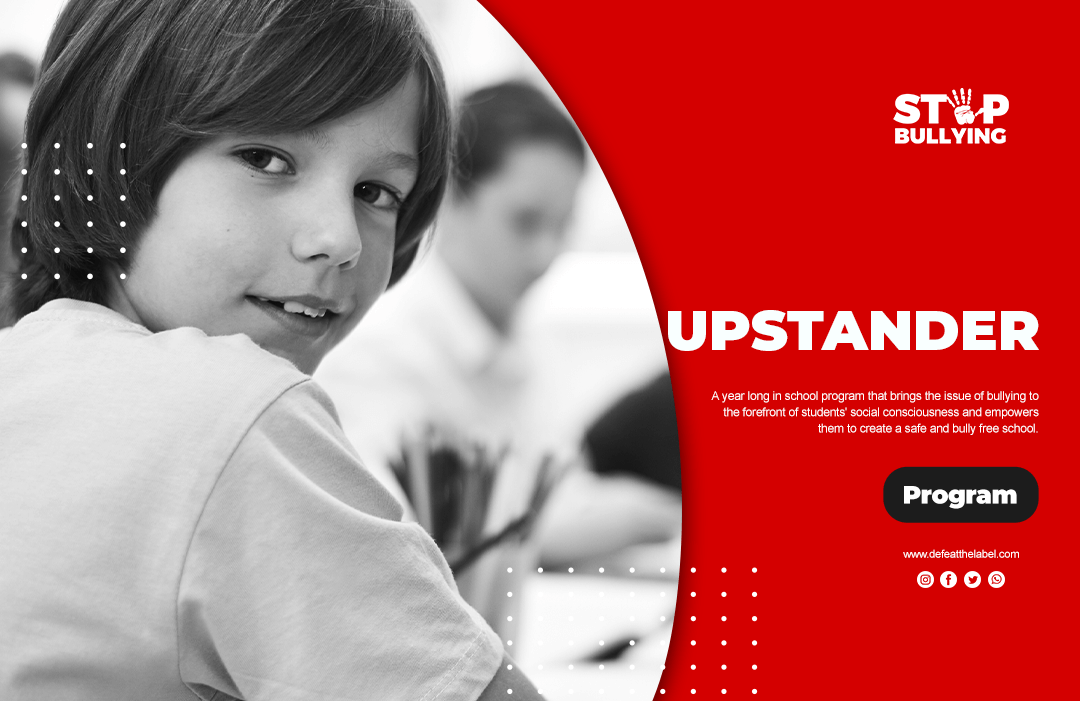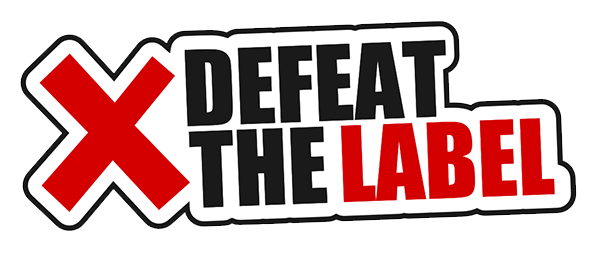
Defeat The Label’s Upstander Program
The Upstander Program is designed to engage students in a meaningful, relevant conversation about negative social behaviors that lead to bullying within their school environment and their communities. This is accomplished through interactive workshops that provide education and promote team building and advocacy for the issue. A total of eight workshops are conducted on a bi-weekly basis, over the course of the school year, and are presented and led by our professional team of facilitators.
The Upstander Program is currently offered at both the Middle School and High School levels. Our Middle School Program content, being taught to 6th and/or 7th grades, is primarily focused on general education on bullying related issues and preventative measures, while the High School Program content includes the same but, additionally, addresses mental health awareness and a slightly more “remedial” approach to bullying situations.
Each lesson is designed to:
- Promote open and honest communication with regard to the many topics and issues related to bullying, that our students are facing, this includes types of bullying and where they stem from.
- To remind students of the importance and benefits of showing empathy in their daily lives.
- To develop the student’s critical thinking skills and promote their leadership qualities.
- Raise awareness on-situations and behaviors that may lead to bullying.
- Equip the students with the knowledge necessary to correctly identify Bullying; to properly differentiate between TEASING and BULLYING.
- Provide instruction and guidance on various methods to safely and effectively intervene in a bullying situation.
- Meet sections of Matt’s Safe School Law in the state of Michigan.
The knowledge gained from each lesson helps to reduce the incidence of “bystander syndrome”; a key element that allows situations to escalate into more dangerous conflicts. It is our hope that participating students will be inspired to devise new ways of spreading the message of tolerance and inclusion throughout their schools and communities.
Why Upstander?
According to a recent study by wallethub.com
Michigan students report that they face some of the worst bullying behavior in the country.
“Wallethub used data collected from the U.S. Census Bureau, Centers for Disease Control and Prevention, Bureau of Labor Statistics, StopBullying.gov, National Education Association, National Center for Education Statistics, Cyberbullying Research Center and GLSEN to create categories that ranked the states on a 100-point scale.
The three categories weighed are: bullying prevalence, bullying impact and treatment and anti-bullying laws. In those three categories, 17 different metrics were considered to determine the scores in each category.
Michigan finished with an overall score of 60.18, nearly a full point higher than Louisiana which is second with a score of 59.34. Michigan placed fifth in bullying prevalence and bullying impact and treatment respectively, and 17th in anti-bullying laws.
Michigan also has the third highest percentage of high school students who say they’ve been bullied on school property and fifth highest percentage of students bullied online. In January 2015, Michigan added cyber bullying to the state anti-bullying law.”
OUTLINE OF UPSTANDER PROGRAM’S 8 LESSONS
Please note that while the lesson titles are roughly the same for both the Middle and High School groups, the content and activities presented do differ based on age and maturity level. Many students take part in the Upstander program at both the Middle School and High School level, and have frequently commented that the programs “are not the same”
Lesson 1: Courage & Teamwork
Discuss the dynamic and the benefits of teamwork along with the importance of courage, and where it can be best applied in the daily lives of our students. This lesson serves as an introduction to our program and the foundation on which our entire program builds.
Lesson 2: Responsibility (Personal & Social)
Initiate conversation between students about social and peer responsibility. The initiative games and media in this lesson are intended to get the students thinking about the idea of what it means to be socially responsible and why it is important to their lives, community and society in general.
This lesson will be used to create awareness among students to care and feel responsible towards what is going on around them. If students feel responsible towards their schoolmates, they will be more inclined to take an active stand against bullying.
Lesson 3: Judgement
The goal of this lesson is to increase awareness about the fact that each person is a unique individual. Everyone has aspects of their identity that are innate or inherited, and cannot be changed; others aspects of someone’s identity are learned behaviors. These identities make us who we are, they make us unique, and whether innate or learned, judgement based on someone’s identity is unfair.
Lesson 4: Stereotypes, Labels & Diversity
The goal of this lesson is to create awareness and empathy among students and to introduce and explain the danger of judgement based on first impressions and “snap judgments”. Students will begin to understand the danger and the impact of misconceptions, stereotyping and assumptions, and will become aware of such incidents in their everyday lives.
This lesson is the first of three lessons that focus on actual bullying concepts. These lessons will be used to create empathy among students towards victims of bullying and to heighten awareness about bullying in general. Updates in this section will include a great emphasis on diversity and biased based bullying, how students can identify these behaviors and respond to them appropriately.
Lesson 5: The Power of Words
The goal of this lesson is to help students learn the impact that their words have on others. This will also have students start to look at their school community around them and start to think about the impacts that others behavior has on them, even as an observer. The goal is to have students be more thoughtful in their everyday behavior, and to realize that even when we do not intend to cause hard, that our actions have far reaching impact on those around us.
Lesson 6: Bullying 101
Students will learn the difference between bullying and teasing and begin to accurately identify the types of bullying they might experience or witness.
The goal of this lesson is to educate students on how to correctly identify bullying behavior, understand the different roles in every bullying scenario and to bring awareness to the fact that it is happening all around them – in their schools, among people they know, and within their own tight knit peer groups. We discuss the impact of bullying, both immediate and the potential long term risks and aim to create a feeling among students that something must be done. Updates to this lesson include a robust outline of cyber bullying on different platforms- social media, gaming, and video sharing, as well as in classroom or meeting settings, what it looks like, and how students can intervene. We will also be working with multiple social media applications to create clear and easy to use guides as to how students can report cyber bullying or harassment, and appropriate steps to take. These will also be housed on our website as a reference for any student who need them.
Lesson 7: Action and Advocacy
The goal of this lesson is to address the “Now what?” After evaluating students’ knowledge of bullying behavior and situations, combined with the understanding of the social emotional impact of both bullying (target or aggressor) and the social emotional impact of bystander behavior, we work with students to create strategies to address bullying behavior head on in their schools.
Over the course of the program, students have learned the skills and been taught the knowledge necessary to evaluate a bullying situation, and ways that they can safely intervene and take action. Now we discuss the programs and resources available to support them. We also strategize with students to create action plans – how will they lead an Upstander movement in their school, how will they speak up. In this lesson, students in many schools have the opportunity to do a hands on project that showcases the knowledge they have learned.
Lesson 8: What will you do?
In this lesson we discuss putting it all together, using the tools that they have learned in the Upstander program to create the Upstander movement in their schools. Students can showcase their ideas and programs.
Please contact us at info@defeatthelabel.com to discuss your specific needs and questions regarding program availability, cost, and financial assistance.

